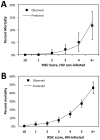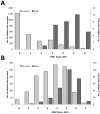Development of the Respiratory Index of Severity in Children (RISC) score among young children with respiratory infections in South Africa
- PMID: 22238570
- PMCID: PMC3251620
- DOI: 10.1371/journal.pone.0027793
Development of the Respiratory Index of Severity in Children (RISC) score among young children with respiratory infections in South Africa
Abstract
Objective: Pneumonia is a leading cause of death in children worldwide. A simple clinical score predicting the probability of death in a young child with lower respiratory tract infection (LRTI) could aid clinicians in case management and provide a standardized severity measure during epidemiologic studies.
Methods: We analyzed 4,148 LRTI hospitalizations in children <24 months enrolled in a pneumococcal conjugate vaccine trial in South Africa from 1998-2001, to develop the Respiratory Index of Severity in Children (RISC). Using clinical data at admission, a multivariable logistic regression model for mortality was developed and statistically evaluated using bootstrap resampling techniques. Points were assigned to risk factors based on their coefficients in the multivariable model. A child's RISC score is the sum of points for each risk factor present. Separate models were developed for HIV-infected and non-infected children.
Results: Significant risk factors for HIV-infected and non-infected children included low oxygen saturation, chest indrawing, wheezing, and refusal to feed. The models also included age and HIV clinical classification (for HIV-infected children) or weight-for-age (for non-infected children). RISC scores ranged up to 7 points for HIV-infected or 6 points for non-infected children and correlated with probability of death (0-47%, HIV-infected; 0-14%, non-infected). Final models showed good discrimination (area under the ROC curve) and calibration (goodness-of-fit).
Conclusion: The RISC score incorporates a simple set of risk factors that accurately discriminate between young children based on their risk of death from LRTI, and may provide an objective means to quantify severity based on the risk of mortality.
Conflict of interest statement
Figures


References
-
- Black RE, Cousens S, Johnson HL, Lawn JE, Rudan I, et al. Global, regional, and national causes of child mortality in 2008: a systematic analysis. Lancet. 2010;375:1969–1987. - PubMed
-
- Williams BG, Gouws E, Boschi-Pinto C, Bryce J, Dye C. Estimates of world-wide distribution of child deaths from acute respiratory infections. Lancet Infect Dis. 2002;2:25–32. - PubMed
-
- Enarson PM, Gie RP, Enarson DA, Mwansambo C, Graham SM. Impact of HIV on standard case management for severe pneumonia in children. Expert Rev Respir Med. 2010;4:211–220. - PubMed
-
- Graham SM, Gibb DM. HIV disease and respiratory infection in children. Br Med Bull. 2002;61:133–150. - PubMed
-
- World Health Organization. Cough and difficult breathing. Pocket book of hospital care for children: guidelines for the management of common illnesses with limited resources. Geneva: World Health Organization; 2005.
Publication types
MeSH terms
Substances
LinkOut - more resources
Full Text Sources
Medical

